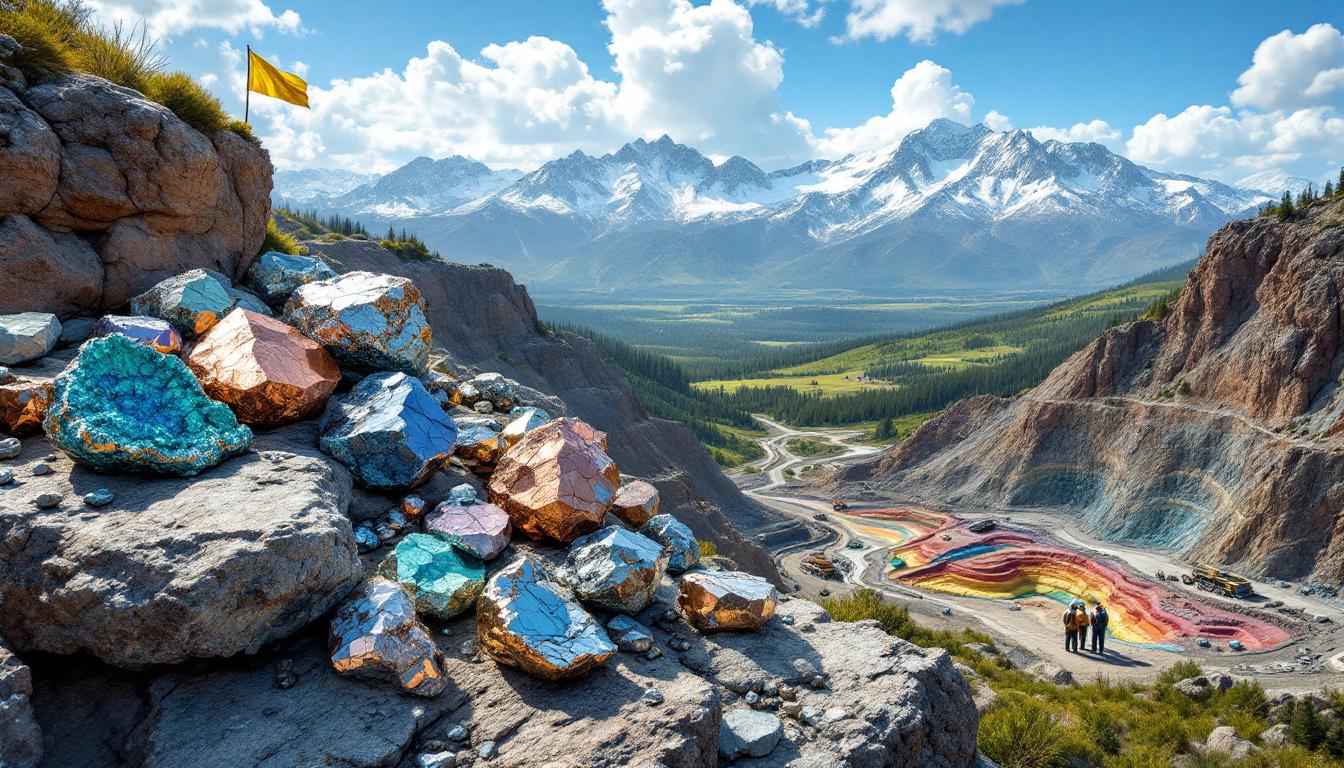What is the Kasiya Rutile Project and Why Does it Matter?
The Kasiya rutile/graphite project in Malawi, owned by ASX- and AIM-listed Sovereign Metals, has received significant validation from a major Japanese titanium producer. This development confirms the project's potential to supply high-quality rutile for premium titanium applications in aerospace and industrial sectors.
The validation from a Japanese titanium producer places Kasiya in a position to become a cornerstone supplier of this critical mineral to high-value manufacturing chains globally. With natural rutile increasingly recognized as a strategic resource, this endorsement elevates the project's importance in the global critical minerals energy security.
Key Project Validation Details
Toho Titanium Company, a respected Japanese titanium metal producer, has thoroughly analyzed samples from the Kasiya project and confirmed that the rutile is "of a quality that can be used without any issues" in high-specification titanium manufacturing. This validation is particularly significant as Toho supplies critical components to aerospace giants like Boeing and Airbus.
Frank Eager, Sovereign Metals' Managing Director and CEO, emphasized the importance of this development: "Toho Titanium supplies the most demanding aerospace applications globally, such as Boeing and Airbus commercial aircraft. Confirmation that our rutile meets Toho's exacting standards validates our position as a future cornerstone supplier to critical industries."
Quality Parameters Confirmed
The Kasiya rutile sample exceeded Toho's stringent requirements across multiple parameters:
- Superior titanium dioxide grade (>95% TiO₂)
- Absence of deleterious elements (particularly low in Cr, Fe, and V)
- Low radiation values (<1 Bq/g, well below aerospace requirements)
- Optimal particle size distribution for processing efficiency
- Appropriate density characteristics for industrial applications
This comprehensive validation across multiple technical parameters demonstrates why Japanese titanium producer interest in Kasiya rutile is significant for the project's commercial prospects.
How Does Rutile Fit into the Titanium Supply Chain?
Understanding Natural Rutile's Value
Natural rutile represents the purest form of titanium dioxide (TiO₂) found in nature, typically containing 93-96% TiO₂. This high purity makes it particularly valuable for manufacturing premium titanium metal products compared to other titanium feedstocks.
While synthetic rutile and titanium slag can also serve as feedstocks for titanium production, natural rutile's inherent purity translates to fewer processing steps, reduced energy consumption, and ultimately, higher-quality end products. This is particularly crucial for applications where material integrity cannot be compromised.
Applications in High-Specification Industries
Rutile from projects like Kasiya serves as a critical raw material for:
- Aerospace components requiring exceptional strength-to-weight ratios
- Medical implants demanding biocompatibility and durability
- Industrial applications needing corrosion resistance
- Defense sector equipment requiring specialized performance characteristics
In titanium metal production, high-purity rutile undergoes chlorination in the Kroll process to produce titanium tetrachloride (TiCl₄), which is then reduced with magnesium to create titanium sponge—the precursor to titanium metal. The initial quality of the rutile directly impacts the performance characteristics of the final titanium products.
What Makes Kasiya's Rutile Strategically Important?
Supply Chain Significance
The validation of Kasiya's rutile by Toho positions the project as a potential cornerstone supplier to critical industries. This is particularly important given:
- Growing concerns about supply chain security for critical minerals
- The strategic importance of titanium in aerospace and defense applications
- Increasing demand for high-purity titanium feedstocks
- Geopolitical pressure to diversify supply sources away from concentrated producers
Recent designations under the EU Critical Raw Materials Act (2023) and U.S. Defense Production Act highlight titanium minerals as strategically important resources, creating additional incentives for development of new supply sources like Kasiya.
Dual-Commodity Advantage
The Kasiya project offers a unique advantage as a dual-commodity operation:
- Primary production of premium natural rutile
- Secondary production of graphite, another critical mineral with applications in batteries and other technologies
This dual-commodity nature provides potential revenue diversification and aligns with the growing demand for battery minerals in the renewable energy transition. Few projects globally offer this combination of critical minerals strategy from a single operation.
Industry Note: While titanium metal accounts for only about 10% of total titanium mineral consumption, it represents the highest-value application with the most stringent quality requirements. The remaining 90% is used primarily in titanium dioxide pigment production.
What Does This Mean for Sovereign Metals?
Commercial Implications
The validation from Toho Titanium represents a significant milestone for Sovereign Metals, potentially:
- Enhancing the project's commercial viability
- Opening doors to premium markets in aerospace and industrial applications
- Strengthening the company's position in negotiations with potential offtake partners
- Supporting financing discussions with potential investors and lenders
The Japanese titanium producer's validation of Kasiya rutile quality could allow Sovereign Metals to pursue premium pricing strategies for this portion of their production, potentially improving overall project economics.
Market Positioning
With Toho's validation, Sovereign Metals can now position Kasiya rutile as a premium product suitable for the most demanding applications in the titanium industry, potentially commanding higher prices than standard rutile products.
This positions Kasiya differently from most rutile projects, which primarily target the larger but lower-value pigment market. By demonstrating suitability for aerospace applications, Sovereign Metals can pursue diversified sales strategies across multiple end-use segments.
How Does This Development Impact the Broader Titanium Industry?
Supply Diversification
The emergence of Kasiya as a validated source of high-quality rutile contributes to:
- Geographic diversification of titanium feedstock supplies
- Reduced reliance on traditional rutile-producing regions
- Enhanced supply chain resilience for critical industries
- Potential stabilization of long-term price volatility
Currently, natural rutile production is concentrated in a handful of countries including Australia, Sierra Leone, and Kenya. The addition of Malawi as a significant producer would help mitigate supply risks for downstream industries.
Quality Benchmarking
Toho's validation establishes a quality benchmark for natural rutile, highlighting the importance of:
- Low impurity levels
- Consistent physical properties
- Suitability for high-specification applications
This validation may raise industry expectations for future rutile projects, potentially accelerating the trend toward higher-purity feedstocks for the titanium metal industry. The Japanese titanium producer's endorsement could influence quality standards throughout the supply chain.
What Are the Next Steps for the Kasiya Project?
Development Timeline Considerations
While the validation represents a significant milestone, several steps remain before Kasiya can begin commercial production:
- Completion of feasibility studies
- Securing of financing
- Development of mining and processing infrastructure
- Establishment of logistics networks
- Regulatory approvals and environmental permitting
The timeline from validation to production typically spans 3-5 years for projects of this scale, though the strategic importance of rutile may attract development support from governments and end-users seeking supply security.
Market Development Opportunities
The validation opens doors for Sovereign Metals to:
- Engage with additional potential customers in the titanium industry
- Explore premium pricing structures for high-specification applications
- Develop long-term supply relationships with key industry players
- Position for potential strategic investments from end-users
Working with a Japanese titanium producer like Toho could provide Sovereign Metals with valuable insights into optimizing their product specifications for the demanding aerospace market segment.
FAQs About Rutile and Titanium Production
What exactly is rutile and how is it used in titanium production?
Rutile is a mineral composed primarily of titanium dioxide (TiO₂). In titanium metal production, high-purity rutile is processed through the Kroll process, where it's converted to titanium tetrachloride and then reduced to metallic titanium using magnesium.
The process involves several steps:
- Chlorination of rutile to form TiCl₄
- Purification of the TiCl₄ through distillation
- Reduction with magnesium to form titanium sponge
- Processing of titanium sponge into ingot, billet, or powder forms
Why is natural rutile preferred over synthetic alternatives?
Natural rutile typically contains fewer impurities that can compromise the mechanical properties of finished titanium products. For aerospace and medical applications requiring the highest performance standards, natural rutile often provides superior results.
Benefits include:
- Lower processing costs (fewer purification steps required)
- Reduced environmental footprint
- More consistent metallurgical performance
- Fewer trace elements that could affect final product properties
How does the quality of rutile affect the final titanium product?
The purity of rutile directly impacts the quality of the resulting titanium metal. Lower levels of impurities like iron, chromium, and vanadium result in titanium with more consistent properties and better performance in demanding applications.
For aerospace-grade titanium, impurity thresholds are extremely strict:
- Iron: typically <0.3%
- Chromium: <0.1%
- Vanadium: controlled to specific levels (added intentionally in some alloys)
- Nitrogen: <0.05%
Understanding these precise requirements requires deep knowledge of mineralogy and ore economics specific to the titanium industry.
What makes the aerospace industry particularly demanding for titanium quality?
Aerospace applications subject materials to extreme conditions including high stress, temperature variations, and potential fatigue. Any inconsistencies or impurities in titanium components could lead to catastrophic failures, making ultra-high-quality titanium essential.
Critical factors include:
- Fatigue resistance in cyclic loading conditions
- Crack propagation characteristics
- Corrosion resistance in various environments
- Consistent mechanical properties throughout components
Disclaimer: While the validation of Kasiya rutile by a Japanese titanium producer represents a significant milestone, investors should note that project development timelines, market conditions, and technical challenges may impact Sovereign Metals' ability to bring the project into production. All forward-looking statements involve inherent risks and uncertainties.
Additional Resources for Understanding Rutile and Titanium
For those interested in exploring the technical aspects of rutile quality and titanium production in greater depth, several industry resources provide valuable insights:
- ASTM International Standards (particularly B299 and B348) outline the specific requirements for titanium sponge and titanium alloys for aerospace applications
- Titanium Metals Corporation (TIMET) Technical Guides offer detailed explanations of titanium production processes
- USGS Mineral Commodity Summaries provide annual updates on global titanium mineral supply and demand trends
- The Japan Titanium Society publishes research on titanium applications and processing technologies
Understanding these resources can provide context for appreciating why the validation of Kasiya rutile by a Japanese titanium producer represents such a significant development for both Sovereign Metals and the broader titanium supply chain.
The development comes at a critical time when European raw materials supply concerns continue to drive strategic investments in new sources of critical minerals. Furthermore, the project showcases how mining industry innovation can deliver high-specification materials needed for advanced manufacturing applications.
Looking to Catch the Next Major ASX Mineral Discovery?
Discovery Alert's proprietary Discovery IQ model identifies significant mineral discoveries on the ASX in real-time, transforming complex announcements into actionable investment insights. Explore how historic discoveries have generated substantial returns by visiting Discovery Alert's dedicated discoveries page and position yourself ahead of the market.




